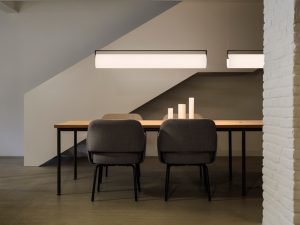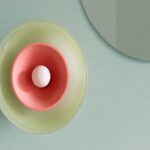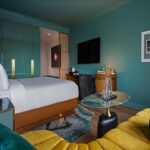Let There Be Light
When it comes to the interior lighting of a corporate space, there are multiple factors to be mindful of. While it has to be light enough for workers to see their desks, studies have shown that lighting effects productivity, efficiency and overall employee wellbeing. KODA Lighting see the effects of organic lighting on productivity and efficiency, and have a variety of ranges focused on facilitating a comfortable work environment.

GALLERY
CIRCADIAN LIGHTING

Circadian rhythm is our natural behavioural, biological and mental changes over a 24-hour cycle, with light and dark having the most prominent effect. Our melatonin and consequent productivity, alertness and sleep cycle are all heavily influenced by this internal clock.
Standard fluorescent lighting affects our circadian rhythm, as there is no external stimuli guiding our body clock. The intent of circadian lighting is to work in harmony with our internal clocks by, when daylight is unavailable, modulating the intensity, spectrum and colour of electric light in replication of the natural lighting cycle.
A circadian lighting system can increase alertness, concentration, boost the immune system, elevate mood, improve memory and cognitive function and overall create a more comfortable working environment.
Circadian lighting ranges also works to improve our relaxation in the evening, enabling deeper and most restful sleep. This is done by switching the temperature of the light from cool tones in the day to warm in the evening, through the use of colour tuning (see below).
COLOUR TUNING

Colour tuning allows the adjustment of temperature of lighting in a building aligned with circadian rhythms. This alignment prevents the disruption of normal sleeping and waking cycles and helps those exposed to the lighting be healthier and more productive. Healthier lighting will makes a work environment more comfortable and pleasant to be in.
Daily periods of natural light have regulated out biological clocks, placing our bodies on a schedule that optimises our exposure to daylight. Artificial light can have just the same biological impact as natural lighting, affecting productivity and circadian rhythm.
Optimal lighting conditions, with specific colour-tuning techniques, can provide a more efficient working environment. Colour tuning, involves modifying either the white, red, green or blue light of sources to produce different colour temperatures. Integrating tuneable lighting into lighting design can regulate circadian rhythm and increase the productivity of employees.
With colour tuning, you can align lighting with circadian rhythms, creating an appropriate mood and encourage productivity. This can also work to minimise the negative impact on mood and cortisol artificial light can have. By using cool tones in the day and warm in the evening, lights can help regulate our productivity and relaxation levels, and when the body should be doing each.
DIRECT AND INDIRECT LIGHTING

While the office should be a place where we thrive, studies have shown there are a variety of negative impacts on health and productivity that arise from poorly designed and badly lit offices. The right light level at the workplace avoids tiredness and lack of concentration.
Direct and indirect lighting are the two most common lighting structures in the workplace. Direct lighting is when the majority of the light spread of a fixture falls on a specific object, such as shining light directly onto a workspace. Indirect lighting is the light spread that lands outside of the direct scope and lights objects other than those in the direct illumination spread, for example, angling a light towards a wall or ceiling and allowing for reflective surfaces to light the area.
Direct lighting, with its focused and intense illumination, is ideal for tasks that require clear visibility. It’s also great for highlighting specific features or objects in a room. On the other hand, indirect lighting, with its soft and diffused glow, is perfect for creating a warm and inviting atmosphere. It’s also beneficial in environments where maintaining focus and concentration is crucial.
The primary consideration for lighting an office is the avoidance of direct glare. When light reflects off screens or surfaces, be it from the sun or from lamps and luminaires within the office, it contributes greatly to fatigue and can adversely affect health and performance. Indirect lighting’s glow, emanating throughout a space, provides the perfect atmosphere for a comfortable and productive work environment.
Direct lighting is still a viable option, however. Through diffuse lighting, the function of direct lighting is served while still being soft and comfortable on the eyes, eliminating glare. Palma is the perfect example and it is a very popular choice as it also integrates the greenery in the design which is a very unique concept.
The lighting in an office space is best utilised when it is a combination of direct and indirect fixtures. Indirect lighting balances direct lighting in a space, to avoid glare and high contrast which may create an uncomfortable environment. With an objective to create uniform lighting in the work space, the balance of the two lighting structures results in a well-lit, yet still comfortable work space.
KODA Lighting Ranges:

Vibia Kontur | Known for its indirect lighting, which has been shown to positively influence workplace ambience.

Vibia Palma | This fixture offers integration with greenery, promoting sustainability initiatives within office spaces.


Occhio Range | Renowned for its white tuning option, providing high-quality light and minimalist design. For instance, the Mito Volo is ideal for desk stations (direct and indirect lighting), the Mito Cosmo is perfect for meeting rooms, and the Mito Terra floor lamp offers both indirect and direct lighting options with the option of moving the light around. Offers gesture control for dimming and light temperature adjustment, ranging from 2700K (warm color) to 4000K (cool color).A-N-D also has a dim-to-warm option integrated into some of their collections.

Vibia Plusminus | With its versatile design, this fixture allows for infinite configurations, adapting seamlessly to any office layout.



A-N-D Vale, Vibia Duo, and Architectural Lighting with Arkoslight | These additional options contribute to a comprehensive exploration of lighting solutions for various office environments.
For more information, visit KODA Lighting
London-based design studio Nina+Co has unveiled Ara, a restaurant that celebrates material authenticity and circular design through the ...
Curiousa founder Esther Patterson has transformed everyday bathroom lighting into an expression of colour, texture and joy with ...
In response to the growing pressures of climate change and population growth, the University of Queensland’s new Plant ...
A landmark café within Athens’ National Gardens has reopened with a new identity, transformed by London-based Neiheiser Argyros ...
Blur Workshop has unveiled a striking redesign of the W Austin, infusing the hotel with colour, texture and ...














